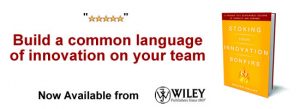Don't Blame the IP Lawyer
 I attended the 2nd Open Innovation Summit in Chicago last week. It was a really good event with many interesting presentations. In the pre-conference workshop, and in the main conference, the subject of obstacles to Open Innovation (OI) came up frequently. In many cases, the devil of the piece was the in-house lawyer. One presenter described herself as a “recovering lawyerâ€. OK, it was said in jest, but it did start me thinking about how lawyers are regarded in innovation projects.
I attended the 2nd Open Innovation Summit in Chicago last week. It was a really good event with many interesting presentations. In the pre-conference workshop, and in the main conference, the subject of obstacles to Open Innovation (OI) came up frequently. In many cases, the devil of the piece was the in-house lawyer. One presenter described herself as a “recovering lawyerâ€. OK, it was said in jest, but it did start me thinking about how lawyers are regarded in innovation projects.
It seems as if the stereotype people have in mind is the risk-averse, backside-covering, couldn’t-care-less-about-innovation ostrich with their head in the sand. Yet when I asked several senior industry people, prominent in OI, whether their legal processes helped or hindered OI, the response was the opposite. All of them said they had great lawyers on the team, who really bought into innovation and helped them get the job done.
I have to say that is exactly my experience, and it led me to reflect on why lawyers appear to have such a bad reputation in the OI world.
First, in many companies there is absolutely no incentive for a lawyer to take a risk. Indeed it’s the opposite. If they authorize a risk that goes the wrong way, they are the people who take the consequences and get kicked, not the core innovation team. You shouldn’t be surprised if their default approach is to rule out all risk.
Second, even when they do approve a project that involves some legal risk, and it all works out (like it usually does), how often do the innovation team go back to the lawyer and say “by the way, thanks for letting us move forward with that project, it really paid off�
Finally, how often is the lawyer seen as part of the team and not an extraneous irritant?
It seems as if companies who “get†OI, also have great lawyers who are part of the team and can balance upside as well as risk. So here’s what I would recommend.
- Ideally, make the lawyer a member of the formal team. If that can’t happen, treat them as if they are on the team.
- Don’t leave the final decision up to the lawyer. After all, legal risk is only one part of a project, there are risks associated with R&D, manufacturing etc. You should have a senior decision maker who decides what will happen based on ALL the inputs.
- When it all works out, say thank you. If it doesn’t work out, treat it as a collective setback for the team, not the individual who put their neck on the line to try to help the innovation succeed.
Don’t kick the lawyer, they really are there to help you.
Don’t miss an article (1,550+) – Subscribe to our RSS feed and join our Continuous Innovation group!
 Kevin McFarthing runs the Innovation Fixer consultancy, helping companies to improve the output and efficiency of their innovation, and to implement Open Innovation. He
Kevin McFarthing runs the Innovation Fixer consultancy, helping companies to improve the output and efficiency of their innovation, and to implement Open Innovation. He
spent 17 years with Reckitt Benckiser in innovation leadership positions, and also has experience in life sciences.
NEVER MISS ANOTHER NEWSLETTER!
LATEST BLOGS
Starbucks and Big Tobacco
Back in the 1950’s smoking was glamorous, and just about everybody who was anybody smoked cigarettes. Then came the discovery, to the shock of millions, that sucking smoke into your lungs might not be good for you. Then came another revelation that one of the substances in tobacco, nicotine, which was used as a poison by the Egyptians during the times of the Great Pyramids, is addictive. People then began a mass exodus from the consumption of nicotine via inhaled smoke.
Read MoreWal-Mart Goes Green – What about your company?
With the price of gas above $3.00, some companies (and hopefully all) are beginning to look at the fuel efficiency of their fleets. Wal-Mart is the most public example of this with its trucking fleet. Its efforts include:
Read More


